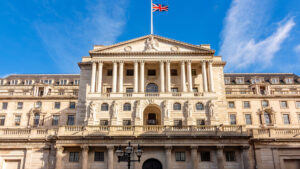The US economy contracted in Q1 2025 due to an import surge at the start of President Donald Trump’s second term in office as he wages a potentially costly trade war.
Behind The Contraction
Q1 GDP contracted at 0.3% QoQ, driven largely by a 5% reduction from net exports and government spending. The data was impacted by a large inventory surplus and a rise in imports, probably in anticipation of tariffs.
This was the first quarter of negative growth since Q1 of 2022. The report comes ahead of the next uncertain steps for Trump’s trade policy. In early April, President Trump announced 10% baseline tariffs on US trade partners as well as reciprocal tariffs against dozens of nations. Trump then paused those tariffs on April 9th for a 90-day negotiation period. ⁽¹⁾

Source: Trading Economics. GDP data in a 3-year timeframe
The Fed’s Dilemma: Inflation, Jobs, and Tariffs
The GDP report adds issues to the Federal Reserve’s decision. While the negative growth number might push the central bank to consider lowering interest rates, inflation readings could give policymakers a pause.
Core inflation held steady at 2.6% YoY, but headline inflation pressures ticked up. This creates a headache for the Federal Reserve, which faces a softening labor market, indicated by Wednesday’s weak ADP jobs report and sticky inflation that may climb temporarily. ⁽²⁾
Fed policy might be impacted by the labor market in 2025. With jobs data in the private sector showing weakness and inflation not yet at target, the Fed might prioritize employment instead of inflation.
The Fed is expected to hold rates steady at its May 7 meeting, with a rate cut expected in June and four 25 basis point rate cuts expected by the end of the year.
Political Pressures and Market Implications
Federal Reserve Chair Jerome Powell is in the political spotlight as a result of the GDP slowdown. President Donald Trump has repeatedly urged rate cuts, and the negative data hands Powell a chance to act without appearing to bow to pressure.
A rate cut could achieve Trump’s goals and stabilize markets. Markets might rally on such a move, interpreting it as data-driven support for a troubled economy. ⁽³⁾
However, if Powell maintains a wait-and-see stance, citing tariff-driven inflation risks, tensions with the White House could become worse. Poor GDP data, paired with a Fed-White House standoff, might increase economic worries and trade war fears, which might lead to a market sell-off.
The stakes are high: Powell’s rhetoric will either calm or inflame markets already jittery about tariffs and growth. ⁽⁴⁾



